With its intriguing name and mythological associations, the Ophiuchus Constellation has captivated the interest of astronomers, historians, and astrology enthusiasts alike. Although lesser known compared to popular constellations like Orion or Ursa Major, Ophiuchus is rich in ancient stories and symbolism that have shaped its significance over time. In this article, we will explore the history, mythology, and depictions of Ophiuchus, delving into its unique position in the sky and its place in both scientific and cultural realms. Prepare to embark on a fascinating journey through the celestial tales and intriguing mysteries of the Ophiuchus Constellation.
Contents
- Overview of Ophiuchus Constellation
- Mythological Stories of Ophiuchus
- Symbolism of Ophiuchus
- Depictions of Ophiuchus in Art and Culture
- Comparisons with Other Constellations
- Scientific Facts and Discoveries about Ophiuchus
- Controversies and Misconceptions
- Ophiuchus in Astrology and Zodiac
- Popular Culture References
- Conclusion
-
Frequently Asked Questions
- What is the origin of the name Ophiuchus?
- How can I locate the Ophiuchus Constellation in the night sky?
- What are the main stars that form Ophiuchus?
- Is Ophiuchus recognized as a zodiac sign?
- What is the significance of Ophiuchus in astrology?
- Are there any famous myths associated with Ophiuchus?
- Does Ophiuchus have any cultural significance outside of Greek mythology?
- What artistic representations of Ophiuchus can be found in history?
- Is Ophiuchus similar to other constellations?
- What scientific discoveries have been made about Ophiuchus?
- References
-
Frequently Asked Questions
- 1. Can you see the Ophiuchus constellation with the naked eye?
- 2. How many stars are there in the Ophiuchus constellation?
- 3. What is the significance of the serpent in Ophiuchus mythology?
- 4. Is Ophiuchus a part of the zodiac?
- 5. What are the main differences between Ophiuchus and Scorpius?
- 6. Are there any famous artworks featuring the Ophiuchus constellation?
- 7. Is there any scientific significance to the Ophiuchus constellation?
- 8. Has the position of Ophiuchus in relation to the zodiac signs changed over time?
- 9. Are there any notable mentions of Ophiuchus in literature or poetry?
- 10. Can Ophiuchus be seen in popular culture, such as movies and TV shows?
- References
- Read More
Overview of Ophiuchus Constellation
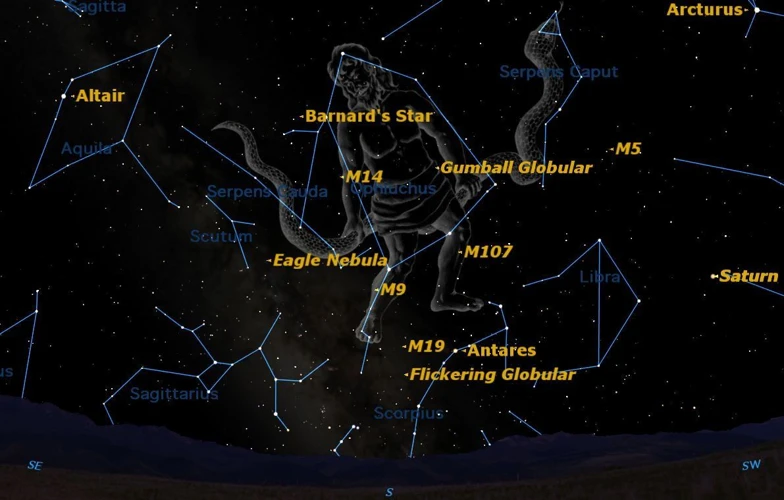
The Ophiuchus Constellation, also known as the Snake Bearer, is an enigmatic and intricate collection of stars that grace the celestial sphere. Steeped in history and mythology, Ophiuchus has fascinated cultures throughout time. Its positioning in the night sky is nestled between Aquila, Serpens, and Hercules, making it a distinctive figure to observe. Notable for its elongated shape, resembling a serpent entwined around a staff, Ophiuchus holds a special place in various belief systems and has been associated with healing, medicine, and wisdom. In ancient Greek mythology, the constellation is linked to the healer, Asclepius, who possessed the ability to resurrect the dead. This intriguing celestial formation continues to inspire and intrigue, embodying the intersection of art, science, and spirituality within the vast cosmos. To explore more about the symbolism and significance of serpents in Ophiuchus, you can read our article on serpent symbolism.
History and Background
The history and background of the Ophiuchus Constellation are steeped in ancient mythology and cultural significance. Dating back to early civilizations such as the Babylonians and the Greeks, Ophiuchus has been observed and revered for centuries. In Babylonian astronomy, it is believed that Ophiuchus represented their legendary hero, Gilgamesh, who embarked on a quest for immortality. The ancient Greeks associated Ophiuchus with Asclepius, the god of medicine and healing, who was known for his ability to revive the dead. The constellation’s depiction as a serpent bearer is linked to Asclepius’ power to heal through the use of serpents. In Chinese mythology, the constellation is sometimes associated with the snake-like beast called “Qiuniu,” known for its ability to ward off evil spirits and bring fortune. Today, Ophiuchus is recognized as the 13th zodiac sign by some astrologers, although this is a subject of debate and controversy. With such a rich and diverse history, the Ophiuchus Constellation continues to capture the imagination and fascination of people around the world.
Characteristics and Positioning
The Ophiuchus Constellation is notable for its distinctive characteristics and positioning in the night sky. Located near the celestial equator, Ophiuchus spans an area of approximately 948 square degrees, making it the 11th largest constellation in the sky. Its shape resembles a man holding a serpent, with the serpent coiling around the central figure. Within Ophiuchus, there are several prominent stars worth mentioning. One of the most well-known stars is Rasalhague, a binary star system located at the serpent’s head. Another notable star is Barnard’s Star, which is one of the closest stars to our solar system. Ophiuchus is visible in both the northern and southern hemispheres, with its highest point in the sky during the summer months in the northern hemisphere. To learn more about legendary figures and constellations, you can explore our article on the legend of King Arthur and the Knights of the Round Table.
Mythological Stories of Ophiuchus
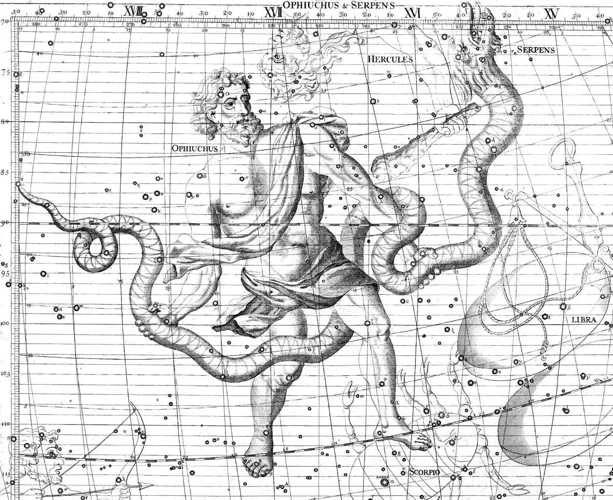
The mythological stories surrounding the Ophiuchus Constellation are as diverse and intriguing as the constellation itself. One of the tales associated with Ophiuchus is the story of the healer. In Greek mythology, Ophiuchus is associated with the figure of Asclepius, the son of Apollo and a renowned healer. Asclepius possessed incredible knowledge of medicine and was known for his ability to bring people back from the brink of death. This divine healing power ultimately led to his downfall, as it sparked the jealousy and fear of Hades, the god of the underworld. To delve deeper into mythical creatures from around the world, you can read our article on mythical Chinese beasts.
Story 1: Ophiuchus the Healer
In the realm of mythology, Ophiuchus holds a prominent role as the healer. The story of Ophiuchus the Healer dates back to ancient Greek mythology, where he is sometimes identified as Asclepius, the son of Apollo. Asclepius possessed extraordinary healing abilities, which he acquired through dedication and divine intervention. Legend has it that he could resurrect the dead, a power that caught the attention of the gods. Jealous of his abilities, the god of the underworld, Hades, complained to his brother Zeus about the disruption this caused in the balance between life and death. To ensure harmony, Zeus struck down Asclepius with a lightning bolt, ending his mortal life. However, in recognition of his healing skills and his contributions to humanity, Zeus immortalized Asclepius by placing him in the heavens as the constellation Ophiuchus. Today, the image of Ophiuchus stands as a symbol of healing and medicine, reminding us of the power of compassion and the pursuit of well-being. The tale of Ophiuchus the Healer continues to inspire medical professionals and serves as a reminder of the ancient wisdom that lies within our celestial myths.
Story 2: Ophiuchus and the Serpent
In the mythological tale of Ophiuchus and the Serpent, the constellation plays a central role in a dramatic celestial struggle. The story begins with the ancient Greek god Apollo gifting Asclepius, a mortal healer and son of Apollo, the knowledge of medicine and the ability to resurrect the dead. Asclepius becomes renowned for his extraordinary healing powers and starts to revive even the deceased, disrupting the natural cycle of life and death. Hades, the god of the underworld, becomes alarmed by this interference and complains to Zeus, the king of gods. To restore balance, Zeus strikes down Asclepius with a lightning bolt, killing him.
However, in honor of Asclepius’s noble work, Zeus raises him to the heavens, immortalizing him as the constellation Ophiuchus. The Serpent, symbolizing both wisdom and healing, is also immortalized and coiled around Ophiuchus as a representation of his power. This celestial battle and subsequent immortalization depict the eternal struggle between life, death, and the power of healing. The recognition of Ophiuchus as a constellation in Greek mythology solidifies its significance as a symbol of healing and wisdom in astronomy and astrology.
Story 3: Ophiuchus in Greek Mythology
In Greek mythology, Ophiuchus holds a significant role as the constellation associated with the renowned healer, Asclepius. According to the myth, Asclepius was the son of Apollo and Coronis. Asclepius possessed remarkable healing powers and became renowned for his ability to revive the dead. One of the most notable stories surrounding Ophiuchus is the tale of how Asclepius learned the secrets of medicine from a snake. Asclepius, in his quest for knowledge and healing, encountered a snake that brought him healing herbs. Impressed by the snake’s wisdom, he killed it and skinned it, using its skin as a girdle that bestowed him with immense healing abilities. However, Zeus, fearing that Asclepius’ skills would upset the balance between life and death, struck him down with a thunderbolt. In honor of his contributions to healing, Zeus immortalized Asclepius as the constellation Ophiuchus in the night sky. This mythological tale showcases the connection between Ophiuchus, medicine, and the eternal quest for healing and knowledge.
Symbolism of Ophiuchus
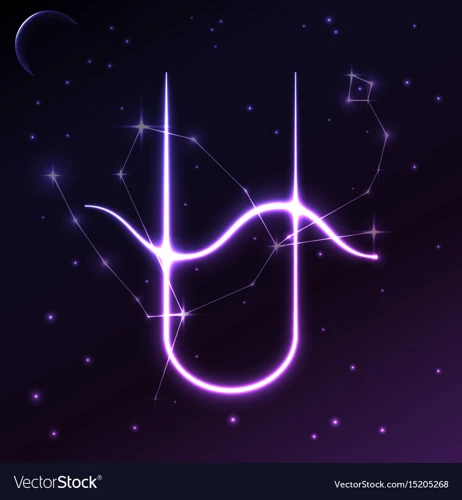
Symbolism plays a significant role in understanding the deeper meaning and significance of the Ophiuchus Constellation. Often depicted as a figure holding a serpent, this symbolism is associated with various interpretations across different cultures and belief systems. One prevalent interpretation is that the serpent represents healing and medicine, linking back to the healer Asclepius in Greek mythology. The intertwined serpent on the staff, known as the Caduceus, is a well-known symbol in the medical field. It represents balance and the harmonious integration of opposites, such as life and death, sickness and health. In addition to healing, the serpent is also seen as a symbol of wisdom, knowledge, and transformation in many cultures. In some ancient mythologies, it is associated with enlightenment and immortality. The serpent shedding its skin is often seen as a representation of rebirth, renewal, and transformation. This notion of transformation is further reinforced by the constellation’s positioning near the end of the zodiac cycle, symbolizing the cyclical nature of life, death, and rebirth. The symbolism of Ophiuchus encompasses a rich tapestry of themes, including healing, wisdom, transformation, and the intricate dance between life and death.
Depictions of Ophiuchus in Art and Culture
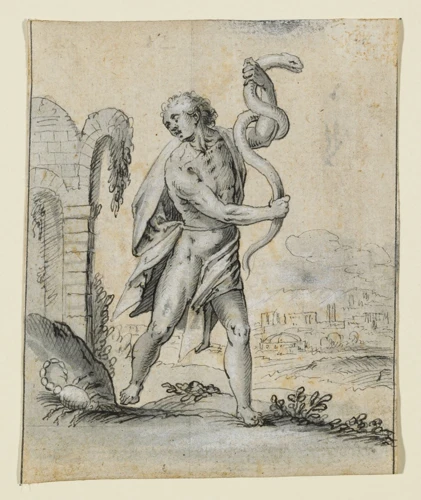
Depictions of Ophiuchus in art and culture showcase the enduring fascination that this constellation holds for humanity. Artists throughout history have sought to capture the mystique and symbolism of Ophiuchus in their works. In ancient Greek art, Ophiuchus is often portrayed as a figure holding a serpent, symbolizing his ability to heal and his association with medicine. Renaissance artists, such as Albrecht Durer, incorporated Ophiuchus into their celestial maps and engravings, contributing to the popularity of the constellation during that era. In contemporary culture, Ophiuchus has found a place in tattoo art, with individuals choosing to adorn their bodies with depictions of the constellation and its associated symbols. Additionally, Ophiuchus has been represented in literature, with authors using the constellation as a source of inspiration for their characters or settings. The diverse and fascinating depictions of Ophiuchus in various art forms highlight the enduring appeal and significance of this celestial figure in the artistic and cultural realm. For more information on other fascinating mythological creatures in different cultures, you can read our article on mythical Chinese beasts.
Comparisons with Other Constellations
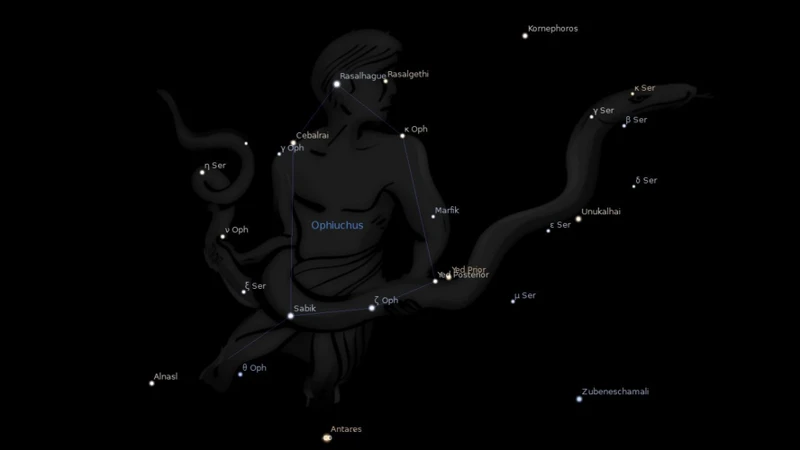
When comparing the Ophiuchus Constellation to other constellations, we can observe intriguing similarities and differences that highlight its unique characteristics. One notable comparison is with the constellation Serpens, which is divided into two parts: Serpens Caput (the Serpent’s Head) and Serpens Cauda (the Serpent’s Tail). Ophiuchus, often depicted as a man holding a serpent, can be seen as intertwined with Serpens Caput, emphasizing the close relationship between the two constellations. Additionally, Ophiuchus is often associated with the neighboring constellation Scorpius, as they share the same region of the sky. Both Ophiuchus and Scorpius are rich in mythological stories, with Ophiuchus often portrayed as a healer and Scorpius as a scorpion battling Orion. These comparative elements shed light on the interconnectedness and symbolic significance of constellations within the vast celestial tapestry.
Ophiuchus vs. Serpens
Ophiuchus and Serpens, both part of the same constellation, are interconnected yet distinct celestial entities. Ophiuchus, often depicted as a man holding a snake, symbolizes the serpent bearer or healer. Serpens, on the other hand, represents the celestial serpent itself. These two components of the constellation have been historically linked due to their proximity in the night sky. Ophiuchus is positioned towards the northwest of Serpens, almost as if he is grasping the serpent. The celestial serpent in Serpens is depicted as a double entity – Serpens Caput (the serpent’s head) and Serpens Cauda (the serpent’s tail). While Ophiuchus is associated with healing and wisdom, Serpens is often associated with rejuvenation and renewal. The intricate relationship between Ophiuchus and Serpens adds an extra layer of mystique to the constellation and showcases the complementary roles they play within its mythological and astronomical context.
Ophiuchus vs. Scorpius
When comparing Ophiuchus to Scorpius, another prominent constellation, several interesting differences emerge. Here are the key points of distinction between the two:
1. Shape and Positioning: Ophiuchus takes the form of a serpent bearer, depicting a figure clutching a serpent. On the other hand, Scorpius represents a scorpion with its distinctive curved tail. In terms of positioning, Ophiuchus lies to the northwest of Scorpius in the night sky.
2. Brightest Stars: Ophiuchus boasts several notable stars, including Rasalhague (Alpha Ophiuchi) and Sabik (Eta Ophiuchi), which shine brightly in the constellation. In contrast, Scorpius is known for its brilliant stars, with Antares (Alpha Scorpii) serving as its most prominent luminary.
3. Mythological Depictions: Ophiuchus and Scorpius share a unique connection in Greek mythology. As the tale goes, Ophiuchus is associated with the healer Asclepius, who was said to have learned the art of medicine from a serpent. This aspect of Ophiuchus becomes significant in the myth of Scorpius, as the scorpion was sent by Gaia (the Earth) to kill Orion, another legendary figure. Consequently, both Ophiuchus and Scorpius are intertwined in the mythic narratives of ancient Greece.
4. Zodiac Sign: While Scorpius is not considered part of the zodiac, Ophiuchus has gained attention in recent years due to its alignment with the ecliptic, which is the Earth’s path around the Sun. This has led to debates about whether Ophiuchus should be considered as a thirteenth zodiac sign or remain an ancient constellation.
Ophiuchus and Scorpius display distinct characteristics in terms of shape, positioning, brightest stars, and mythological connections. Understanding these unique traits allows for a deeper appreciation and exploration of these fascinating constellations in the night sky.
Scientific Facts and Discoveries about Ophiuchus
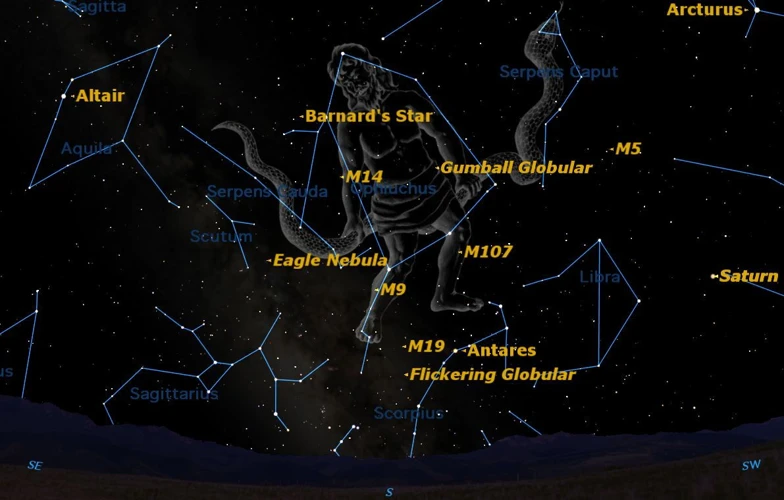
Ophiuchus, the mesmerizing constellation, has not only captured the imagination of mythological storytellers but also the attention of scientists and astronomers. The scientific exploration of Ophiuchus has revealed fascinating facts and discoveries about this celestial phenomenon.
One significant scientific aspect of Ophiuchus is its star count. Although it does not boast numerous bright stars like some other constellations, Ophiuchus still contains several notable stars worth mentioning. Among them is Rasalhague, an Alpha-2 type main-sequence star and the brightest in the constellation. Another notable star is Barnard’s Star, a red dwarf located relatively close to our solar system, making it one of the nearest known stars to Earth.
Astronomers studying Ophiuchus have also made important discoveries in regard to celestial objects associated with the constellation. Ophiuchus houses a number of stunning nebulae, including the Pipe Nebula and the Snake Nebula, which add to its allure. These nebulous regions are characterized by vast clouds of gas and dust, where stars are born and take shape.
Modern astronomical observations have led to the identification of various deep-sky objects within Ophiuchus. One notable example is the Ophiuchus Galaxy Cluster, a massive grouping of galaxies located approximately 390 million light-years away. This cluster is renowned for its large number of galaxy members and has provided valuable insights into the dynamics of galaxy clusters and their formation.
Through continued scientific research and advancements in technology, our understanding of Ophiuchus and its intricate cosmic tapestry continues to expand. Each new discovery brings us closer to unraveling the secrets that lie within this captivating constellation.
Controversies and Misconceptions
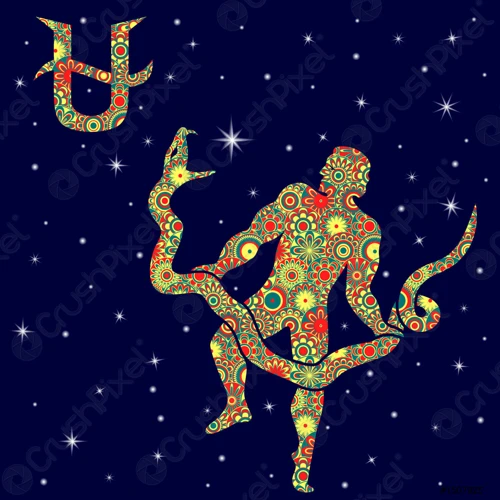
The Ophiuchus Constellation, like many celestial entities, is not without its fair share of controversies and misconceptions. One prevalent controversy revolves around the idea of Ophiuchus being considered the 13th zodiac sign. While some astrologers argue for its inclusion, stating that the Sun passes through Ophiuchus for a portion of the year, mainstream astrology has traditionally recognized only 12 zodiac signs. This debate sparks discussions about the validity and accuracy of astrological systems and their interpretations. Additionally, there is a misconception that the alleged “shift” of the zodiac signs, which gained widespread attention in 2011, changed everyone’s astrological sign. However, this notion is misleading as the concept of the zodiac shift was based on the ancient Babylonian zodiac system, and it doesn’t affect the majority of modern Western astrology. These controversies and misconceptions surrounding Ophiuchus serve as a reminder of the complexities and ongoing debates within the realm of astrology and celestial interpretations.
Ophiuchus as the 13th Zodiac Sign
The idea of Ophiuchus as the 13th zodiac sign has been the subject of much debate and controversy. Traditional astrology recognizes 12 zodiac signs, each representing a specific period of the year. However, proponents of Ophiuchus argue that it should be included as a recognized sign within the zodiac system.
Ophiuchus is often referred to as the “Serpent Bearer” or the “Serpent Holder,” owing to its association with the serpent in mythology. Supporters of Ophiuchus as a zodiac sign claim that those born between November 29 and December 17 fall under this constellation.
Advocates argue that including Ophiuchus would provide a more accurate representation of the alignment of the planets and celestial bodies at the time of an individual’s birth. They believe that Ophiuchus possesses distinct characteristics and influences that should be acknowledged in astrological interpretations.
However, critics of the 13th zodiac sign view it as a disruption to the traditional zodiac system. They argue that shifting from a 12-sign system to 13 would require significant adjustments, including recalibrating the dates associated with each sign.
It’s important to note that the concept of Ophiuchus as a zodiac sign is not universally accepted or recognized by mainstream astrology. The decision to include or exclude it ultimately depends on individual astrological beliefs and interpretations.
The controversy surrounding Ophiuchus as the 13th zodiac sign reflects the ongoing evolution and reevaluation of astrology. While some embrace the addition of Ophiuchus, others prefer to adhere to the traditional zodiac system with its 12 signs.
The Zodiac Shift and Ophiuchus
The Zodiac Shift and Ophiuchus
– Ophiuchus has recently gained attention due to the notion of a “Zodiac shift,” which suggests the inclusion of a 13th zodiac sign alongside the traditional 12 signs of the Zodiac. This hypothetical alignment alteration is based on the precession of the Earth’s axis, resulting in a slight shift in the positions of the constellations over time.
– According to this concept, Ophiuchus would be assigned as the new zodiac sign for those born between November 29th and December 17th. This has caused debates and conflicting opinions among astrologers and enthusiasts regarding the validity and implications of adding Ophiuchus to the existing Zodiac system.
– However, it is important to note that the Zodiac, as we know it today, is primarily based on the Babylonian system, which was established over 2,000 years ago. While Ophiuchus may be present in the sky, it was not included in the original Zodiac division.
– Additionally, the division of the Zodiac into 12 signs of equal length is a convenient mathematical construct. Each sign represents 30 degrees of celestial longitude, aligning with the orbit of the Sun around the Earth throughout the year.
– The inclusion of a 13th Zodiac sign would disrupt this equal division and potentially alter the characteristics and interpretations associated with each sign. Some astrologers argue that Ophiuchus should be recognized and integrated, while others maintain that it is unnecessary and would only complicate the established system.
– It is important to understand that the Zodiac, as practiced in astrology, is subjective and varies across different cultures and belief systems. While Ophiuchus may have its significance and symbolism, its inclusion or exclusion from the Zodiac is a matter of interpretation and personal choice.
Ophiuchus in Astrology and Zodiac
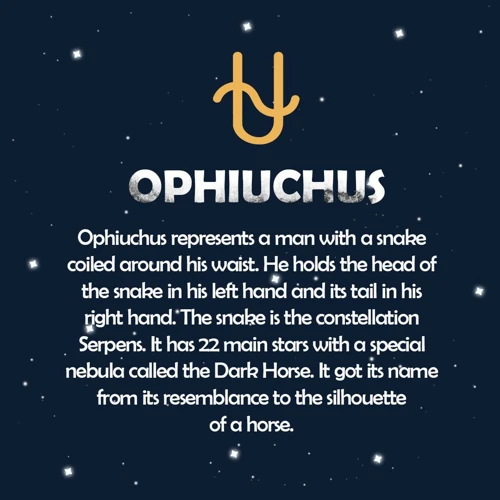
In the realm of astrology and the Zodiac, Ophiuchus has long been a subject of controversy and debate. Traditionally, the Zodiac consisted of twelve signs, each associated with specific traits and characteristics. However, the discovery and inclusion of Ophiuchus as a thirteenth sign introduced a level of uncertainty and sparked discussions among astrologers. Those who advocate for Ophiuchus argue that individuals born between November 29th and December 17th should identify with this sign. They attribute qualities such as healing, wisdom, and serpentine transformation to those born under Ophiuchus. On the other hand, skeptics argue that the Zodiac should remain unchanged, with twelve signs representing the twelve divisions of the year. As a result, the inclusion of Ophiuchus as a zodiac sign remains a point of contention within astrological circles. While some may embrace this new addition and explore the potential impact on their horoscopes, others may choose to adhere to the traditional system. Ultimately, the choice of whether to embrace Ophiuchus as a zodiac sign or not lies with the individual, allowing for personal interpretation and belief.
Popular Culture References
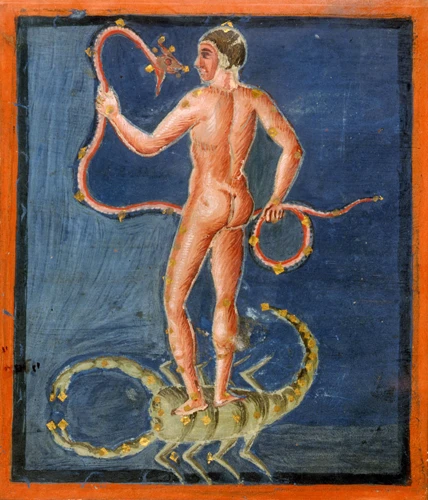
Popular culture has not been immune to the allure of the Ophiuchus Constellation, as it has made appearances in various forms of entertainment and art. In literature and poetry, Ophiuchus has been referenced in works such as “Paradise Lost” by John Milton, where it symbolizes the resurgence of hope and healing. Within the realm of movies and TV shows, Ophiuchus has also left its mark. One notable mention can be found in the hit TV series “Supernatural,” where the character Bobby Singer wears an amulet adorned with the Ophiuchus symbol, signifying his role as a wise and skilled mentor. Ophiuchus has inspired visual artists who have incorporated its celestial beauty into their creations. From stunning paintings to intricate tattoos, the mystique of Ophiuchus continues to enthrall individuals across various artistic mediums, solidifying its place in popular culture references.
Mentions in Literature and Poetry
Mentions of the Ophiuchus Constellation can be found in various works of literature and poetry, where its mythical and astrological associations have served as a source of inspiration. In the realm of literature, Ophiuchus has been referenced in the context of astrology and the zodiac signs. Poets have often used the image of the serpent bearer to symbolize healing, wisdom, and the power to transcend boundaries. In T.S. Eliot’s renowned poem “The Waste Land,” Ophiuchus is mentioned as part of the astrological imagery, adding to the mystical and esoteric themes of the poem. The constellation has also been touched upon in modern literary works exploring mythology and the ancient world, weaving its presence into tales of heroism and adventure. The inclusion of Ophiuchus in literature and poetry not only showcases its enduring significance but also highlights how it continues to captivate the imagination of writers, allowing the constellation to transcend its celestial existence and become a symbol of human experience and consciousness.
Ophiuchus in Movies and TV Shows
Ophiuchus has made appearances in movies and TV shows, often drawing on its mythological connections and astrological significance to add an element of mystery and intrigue to the storyline. In the popular TV show “Supernatural,” Ophiuchus is depicted as a powerful figure associated with healing and possessing supernatural abilities. The character is portrayed as an immortal being, capable of manipulating energy and using it to restore life. Another notable appearance of Ophiuchus is in the fantasy movie “The Sorcerer’s Apprentice,” where the constellation plays a pivotal role in the battle between good and evil. In this film, the main character becomes the apprentice of a master sorcerer who draws power from Ophiuchus to defeat the forces of darkness. These portrayals highlight the mystical and magical qualities attributed to the constellation, emphasizing its connection to supernatural abilities and the spiritual realm. Ophiuchus continues to captivate audiences in the realm of entertainment, weaving its celestial lore into compelling narratives that blend fantasy and reality.
Conclusion
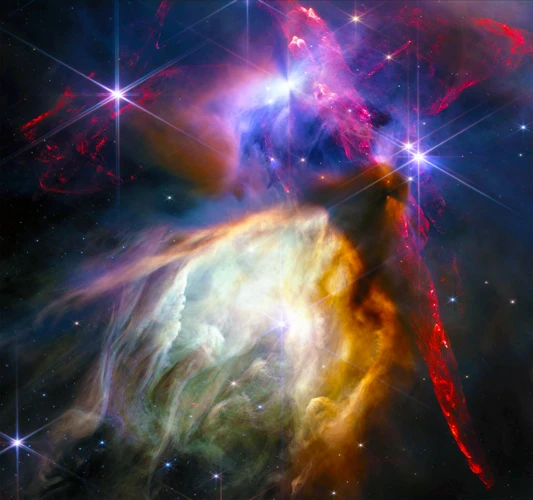
In conclusion, the Ophiuchus Constellation is a captivating celestial formation that has sparked intrigue and curiosity throughout history. From its rich mythological tales to its unique symbolism in various cultures, Ophiuchus holds a significant place in both art and science. Its association with healing, wisdom, and serpents adds to the enigmatic allure of this constellation. While Ophiuchus may not be as widely recognized as other constellations, its presence in the night sky serves as a reminder of the vastness and beauty of our universe. Whether you are an astronomy enthusiast, a mythology buff, or simply someone who appreciates the wonders of the cosmos, exploring the stories and symbolism of the Ophiuchus Constellation is sure to be a fascinating journey. So, take a moment to gaze up at the stars, and let the mysteries of Ophiuchus fuel your imagination and deepen your appreciation for the wonders that lie beyond our earthly realm.
Frequently Asked Questions
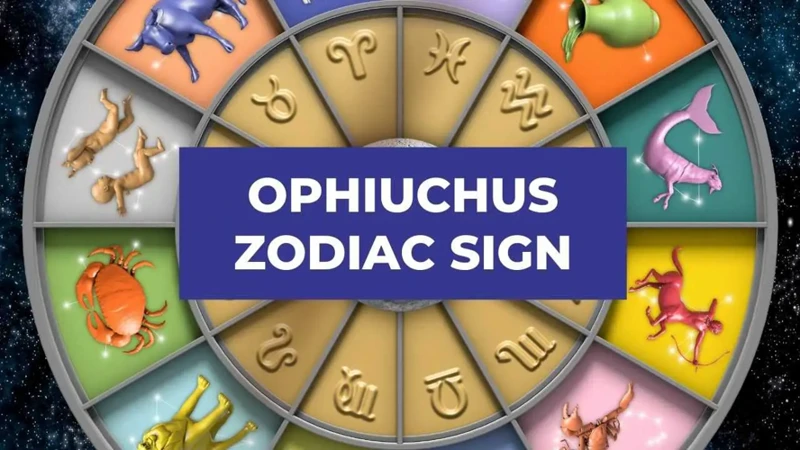
What is the origin of the name Ophiuchus?
The name Ophiuchus is derived from the Greek word “ophis,” meaning snake or serpent, and “ouchos,” which translates to holding or bearing. Hence, Ophiuchus is often referred to as the “Snake Bearer.”
How can I locate the Ophiuchus Constellation in the night sky?
Ophiuchus can be spotted in the northern hemisphere during summer nights. Look for its distinct shape, resembling a human figure holding a serpent, between the constellations of Scorpius and Aquila.
What are the main stars that form Ophiuchus?
Ophiuchus consists of several prominent stars, including Rasalhague (Alpha Ophiuchi), Sabik (Eta Ophiuchi), and Cebalrai (Beta Ophiuchi). These stars, along with others, form the recognizable silhouette of the Snake Bearer.
Is Ophiuchus recognized as a zodiac sign?
While Ophiuchus is not officially recognized as one of the twelve zodiac signs, it has gained attention as a suggested thirteenth sign due to the precession of the Earth’s axis over thousands of years.
What is the significance of Ophiuchus in astrology?
In astrology, Ophiuchus is said to symbolize healing, medicine, and wisdom. Those born under this sign are believed to possess powerful intuition and the ability to bring balance and harmony to others.
Are there any famous myths associated with Ophiuchus?
Yes, Ophiuchus is often associated with the myth of Asclepius, the Greek god of healing. According to the legend, Asclepius learned the art of medicine and healing from a serpent and became renowned for his ability to resurrect the dead.
Does Ophiuchus have any cultural significance outside of Greek mythology?
Apart from Greek mythology, Ophiuchus is also associated with various cultural beliefs and traditions. For example, in Chinese astrology, the constellation is linked to the mythical Chinese beast, known as the Azure Dragon.
What artistic representations of Ophiuchus can be found in history?
Ophiuchus has been depicted in various works of art throughout history, such as ancient cave paintings, classical sculptures, and medieval tapestries. These representations often showcase the Snake Bearer figure accompanied by serpents.
Is Ophiuchus similar to other constellations?
Ophiuchus shares close proximity with the constellations of Serpens and Scorpius. Serpens is divided into two parts: Serpens Caput (the Serpent’s Head) and Serpens Cauda (the Serpent’s Tail), which are found on either side of Ophiuchus. Scorpius, on the other hand, lies just beside Ophiuchus and forms a striking celestial duo.
What scientific discoveries have been made about Ophiuchus?
Scientists and astronomers have studied Ophiuchus extensively. One notable discovery is the Ophiuchus Supercluster, a colossal concentration of galaxies located in the direction of the constellation. Additionally, Ophiuchus has provided insights into star formation and binary star systems.
References
Frequently Asked Questions

1. Can you see the Ophiuchus constellation with the naked eye?
Yes, the Ophiuchus constellation can be seen with the naked eye. It is located near the celestial equator and is visible from most parts of the world.
2. How many stars are there in the Ophiuchus constellation?
The Ophiuchus constellation contains several bright stars, including Rasalhague, Sabik, and Cebalrai. In total, there are over 100 known stars within its boundaries.
3. What is the significance of the serpent in Ophiuchus mythology?
In Ophiuchus mythology, the serpent plays a prominent role. It is often depicted as the Serpent Holder wrapped around Ophiuchus, representing wisdom, healing, and the duality of life and death.
4. Is Ophiuchus a part of the zodiac?
While Ophiuchus is not officially recognized as one of the zodiac signs, it is sometimes referred to as the “13th sign” due to its position along the ecliptic.
5. What are the main differences between Ophiuchus and Scorpius?
Although both Ophiuchus and Scorpius feature the serpent in their mythology, they are distinct constellations. Ophiuchus is often depicted as a healer, while Scorpius is associated with the scorpion and represents the battle between Orion and the scorpion.
6. Are there any famous artworks featuring the Ophiuchus constellation?
Yes, several famous artworks depict the Ophiuchus constellation. One notable example is the Farnese Atlas, a Roman statue that shows Atlas carrying the heavens on his shoulders, with the Ophiuchus constellation visible on his globe.
7. Is there any scientific significance to the Ophiuchus constellation?
Yes, the Ophiuchus constellation has scientific significance. It has been studied by astronomers for its star formations, stellar clusters, and other celestial phenomena. Scientists have also discovered exoplanets within this constellation.
8. Has the position of Ophiuchus in relation to the zodiac signs changed over time?
The position of Ophiuchus in relation to the zodiac signs has remained relatively consistent over time. However, due to the precession of Earth’s axis, there have been slight shifts in the alignment of constellations in relation to the astrological zodiac signs.
9. Are there any notable mentions of Ophiuchus in literature or poetry?
Yes, Ophiuchus has been mentioned in various works of literature and poetry. It is often portrayed as a symbol of healing, knowledge, and the exploration of the unknown.
10. Can Ophiuchus be seen in popular culture, such as movies and TV shows?
Yes, Ophiuchus has made appearances in popular culture, particularly in science fiction and fantasy genres. It is often used as a symbol of mysticism, power, and the pursuit of hidden truths.
References
- Ophiuchus
- The Astronomer’s Guide to Ophiuchus Constellation
- See the Celestial Snake Handler in the Night Sky Now






